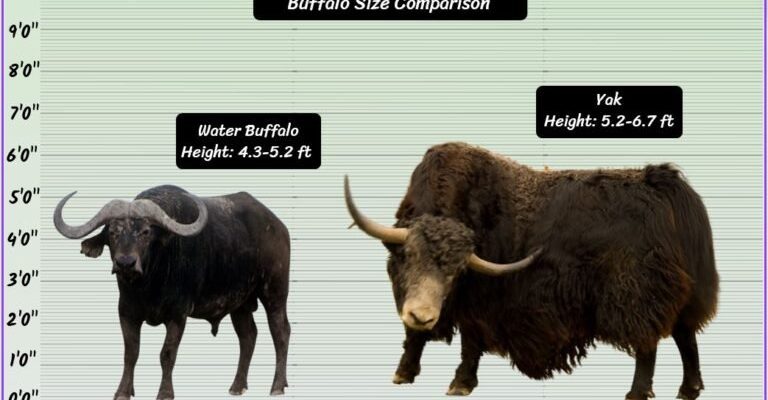![Comparing The Yak Vs. [Similar Species]](https://gudri.com/wp-content/uploads/2025/06/Comparing_The_Yak_Vs___Similar_Species__image_0.jpg)
Imagine sitting on a breathtaking hillside, surrounded by the rugged mountains of Tibet, where yaks graze, their thick coats shimmering in the sunlight. In contrast, picture the expansive grasslands of North America where bison roam in herds, their powerful forms striking against the vast horizon. Both animals play crucial roles in their respective ecosystems, and understanding their differences can deepen our appreciation for wildlife. So, let’s explore these majestic beasts in detail!
Physical Characteristics
When you look at a yak and a bison, the first thing you might notice is their size and shape. **Yaks** are typically smaller than bison, averaging around 5 to 6.5 feet tall at the shoulder. They have long, shaggy hair that helps them withstand the cold temperatures of their mountain habitats. The color of their fur can vary from black to brown. Their distinctive horns curve outward and have a broad base, giving them a unique silhouette.
On the other hand, **bison** are much larger and bulkier, standing around 5 to 6 feet tall but can weigh up to 2,000 pounds or more! Their coats are thick and can change color with the seasons—dark brown in winter and lighter brown in summer. Bison also have a massive hump on their back, which is actually a muscle that supports their heavy head.
Adaptations to Environment
Both yaks and bison have adapted wonderfully to their environments. Yaks are hardy creatures that thrive in high altitudes. They have specialized lungs that allow them to breathe easily in thin air. Their long, shaggy hair not only keeps them warm but also provides protection from the wind and snow.
Bison, meanwhile, have adapted to life on the plains, developing strong legs for running long distances and a thick coat that insulates them during harsh winters. They often wallow in mud to cool down and protect themselves from insects. This behavior shows how both animals have evolved to survive in their unique habitats.
Habitat and Range
Yaks are native to the mountainous regions of Central Asia, especially Tibet, where the air is thin and the temperatures can plummet. They’re often found at altitudes of 10,000 feet or more! Yaks are excellent at navigating rugged terrains, making them perfect companions for local herders.
In contrast, bison are primarily found in North America, especially in places like Yellowstone National Park. They thrive in grasslands and prairies, where they can graze on the abundant grasses. Their range once spanned millions of acres, but due to hunting and habitat loss, their distribution has significantly shrunk.
Social Behavior
Socially, yaks and bison exhibit interesting differences. **Yaks** are usually found in small herds led by a dominant female. The herd structure is a bit tight-knit, with strong bonds developed among members. This social organization helps them protect one another from predators like wolves.
**Bison**, on the other hand, are more social and live in larger herds that can number in the hundreds. These herds often split into smaller groups, especially during the summer. Bison are known for their curious nature, and while they can be gentle grazers, they can also become aggressive if they feel threatened, especially during mating season.
Diet and Feeding Habits
When it comes to food, both animals are herbivores, but their diets reflect their environments. Yaks primarily feed on high-altitude grasses, shrubs, and herbs. Their strong digestive systems can break down tough plant materials, which is essential for survival in the harsh mountainous terrain.
Bison enjoy a more varied diet, primarily consuming grasses and sedges found in the prairie. They can graze for long hours and have even been known to uproot plants to get to their food. Bison play an important role in their ecosystem by helping to maintain the grasslands, allowing new plants to grow.
Conservation Status
Conservation efforts for yaks and bison differ significantly due to their distinct histories. **Yaks** are primarily domesticated and raised by local herding communities. Although they aren’t endangered, their wild relatives face threats from habitat loss and climate change. Protecting their natural habitat is essential for ensuring their survival.
**Bison**, however, were once on the brink of extinction due to excessive hunting in the 19th century. Today, conservation efforts have helped their populations rebound, but they still face challenges, such as habitat loss and genetic diversity issues. National parks and reserves are critical for their ongoing recovery.
While the yak and the bison may seem similar at first glance, they are unique animals with fascinating differences. From their physical traits to their habitats and social behaviors, each creature plays a vital role in the ecosystems they inhabit. Understanding these differences enhances our appreciation of wildlife and reminds us of the importance of conservation in preserving these spectacular species.
By comparing the yak and the bison, we gain insights into how diverse life can be, even among creatures that share similar environments. Next time you hear about these animals, you might think about their unique stories and the environments they call home. Whether you’re in the Himalayas or the plains of the Midwest, the presence of these magnificent creatures enriches our world.

